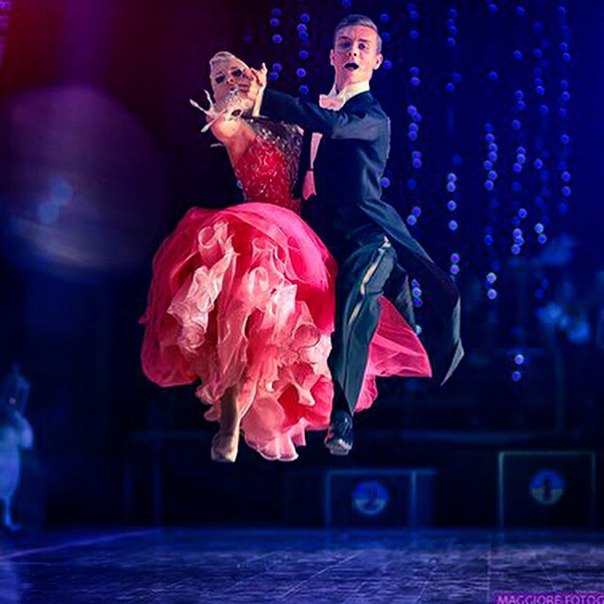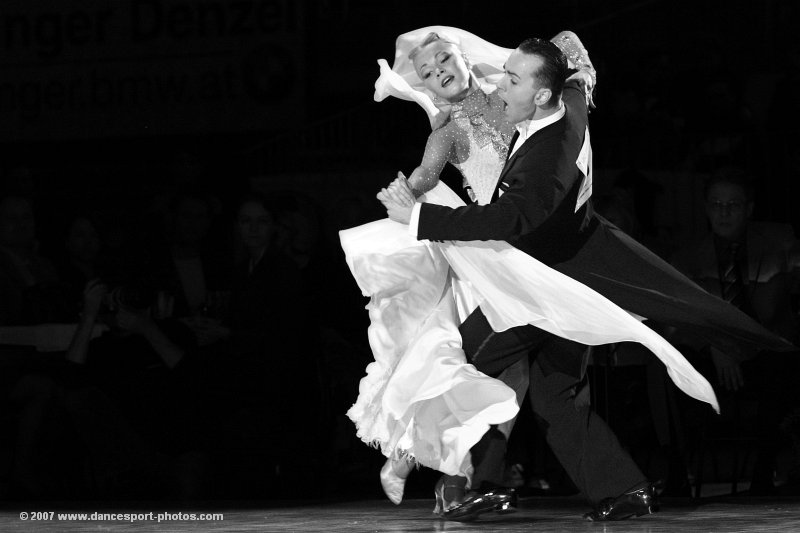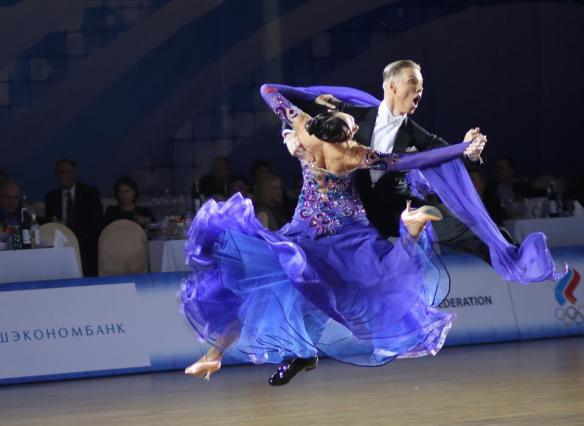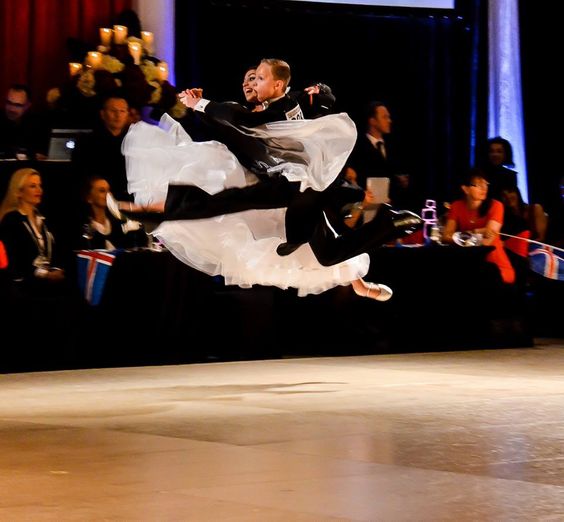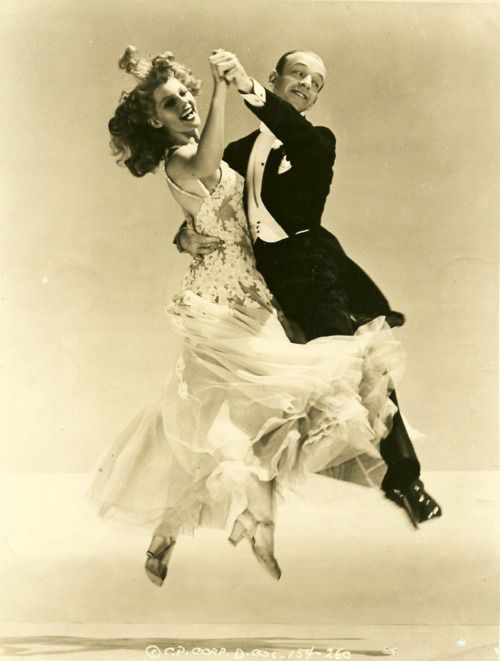Quickstep
See also: Categories: Dances, History, Ballroom, DanceSport, Standard
Time signature: 4/4
Measures per minute (MPM): 45 - 50
Beats per minute (BPM): 200 - 208
Basic Rhythm: Slow-Quick-Quick
Music: Up-tempo jazz/swing music
Year: 1840's-1850's/1910's-1920's
Origin: England/Suburban New York, USA
Definition
Overview
This dance might be termed the "joy" dance of modern dancing. While the basic figures are quite simple, the tempo of the music and the whole character of the dance seem to invite a carefree interpretation of its bright rhythm. The beginner will find the basic steps easy to learn and easy to fit the music. The advanced dancer will discover that the music lends itself to an infinite variety of steps.The dancer who masters the fundamentals of the Quickstep will have command of a dance that can never grow stale, a dance that is unquestionably the most attractive expression of rhythm the world has ever known.
History
1840's-1850's
The Quickstep was originally a march that became popular around the year 1850. It was mainly used to celebrate Presidents, the military, Exhibitions, Regiments, Heroes, etc. It was basically used as a type of propaganda and morale music as well.Later Evolution
Developed during World War I in suburban New York, the Quickstep was initially performed by the Caribbean and African dancers. It eventually made its debut on the stages of American music halls and immediately became popular in Ballrooms.Foxtrot and Quickstep have a common origin. In the twenties, many bands played the Slow-Foxtrot too fast. Eventually, they developed into two different dances. The Slow-Foxtrot tempo was slowed down and Quickstep became the fast version of the Foxtrot.
England
1925 began the Charleston fever and it had a lot of influence on the development of the Quickstep. The English developed the Quickstep from the original Charleston as a progressive dance without kicks and mixed in the fast Foxtrot. They called this dance "the QuickTime Foxtrot and Charleston".As Quickstep is English in origin as well, it was standardized in 1927 at the Star Championships. The English couple Frank Ford and Molly Spain danced a version of the QuickTime Foxtrot and Charleston without the characteristic Charleston knee actions and made it dance for two instead of a solo.
There was a debate as to why this dance became so popular in Britain. It has been thought that the Quickstep was Britain's answer to keeping warm indoors during the winter. It is a proven fact that the energy exerted while dancing a 60-second Quickstep is equivalent to running a mile in record time!
Other than the Foxtrot and the Charleston, the Quickstep also evolved from a combination of The Chase G Chug, the Shag, the Peabody, the One Step, the March, and the Black Bottom and merged all together to make the Quickstep dance of today.
Characteristics
Elegant, smooth, and glamorous, Quickstep dancers are energetic while appearing extremely light on their feet. It should appear that the feet of the dancers barely touch the ground. Much like the Foxtrot, dancers should strive for elegance, being a very form-intensive dance. Upper body posture must be straight and strong throughout each movement.While it evolved from the Foxtrot, the Quickstep now is quite separate. Unlike the modern Foxtrot, the man often closes his feet and syncopated steps are regular occurrences (as was the case in early Foxtrot). Three characteristic dance figures of the quickstep are the chassés, where the feet are brought together, the quarter turns, and the lock step.
This dance gradually evolved into a very dynamic one with a lot of movement on the dance floor, with many advanced patterns including hops, runs, quick steps with a lot of momentum, and rotation.
Rhythm and Music
The Quickstep usually follows a 4/4 time pattern. The basic feel of the Quickstep is slow-quick-quick, slow-quick-quick, with "slow" taking beats one and two, and "quick-quick" taking beats three and four. Most of the "slow" steps are taken on the heel, while most "quick" steps are taken on the balls of the feet.The tempo of quickstep dance is rather brisk as it was developed to ragtime era jazz music which is fast-paced when compared to other dance music.
By the end of the 20th century, the complexity of Quickstep, as exhibited by advanced dancers, had increased due to the extensive use of syncopated steps with eighth note durations. While in older times Quickstep patterns were counted with "quick" (one beat) and "slow" (two beats) steps, many advanced patterns today are cued with split beats, such as "quick-and-quick-and-quick, quick, slow", with there being further steps on the "and's".
Syllabus
The two International Style Standard syllabi of ISTD and IDTA for Quickstep differ very little.The American Style dance competition program does not include Quickstep, but a limited version of the dance is taught. Social Dancing in some American dance venues may showcase Quickstep as well.
Pre-Bronze
- Quarter Turn to Right
- Natural Turn
- Natural Turn with Hesitation
- Natural Pivot Turn
- Natural Spin Turn
- Progressive Chassé
- Chassé Reverse Turn
- Forward Lock
- Heel Pivot (Quarter Turn to Left)
Bronze
- Closed Impetus
- Back Lock
- Reverse Pivot
- Progressive Chassé to Right
- Tipple Chassé to Right
- Running Finish
- Natural Turn and Back Lock
- Double Reverse Spin
- Zig Zag, Back Lock, Running Finish
- Cross Chasse
- Change of Direction
Silver
Gold
Similar Topics
